Haramachi Cultural Properties (Other)
46. Godaisan (Mt. Godai)
Location: Haramachi-ku, Baba, Godaisan
Google Maps: Mt. Godai
The 11th lord of the Soma clan, Soma Shigetane, became ill with an incurable disease after being the head of the clan for only 4 years (1436-1440) He gave up his position to his son Takatane and went into retirement at Mt. Godai, entering the Buddhist priesthood and taking care of his health. Only his two vassals, his uncle and nephew both named Taro, took care of his daily necessities, and it is said that even his wife was prohibited from meeting him. It is thought that Shigetane’s retirement land stretched along the ridge at the top of the mountain, in a rectangle of levelled earth measuring 67 meters north to south and 16 meters east to west. There you can find tens of black stones thought to be the foundation stones of buildings scattered across the area. A thin stream runs through what is thought to have been the front garden even now, becoming a thread-thin waterfall that falls 20 meters.
There also remains a legend that a golden chicken was buried here. Many people heard this story and came to look for it, but none were able to find it.
There is a large basin said to have been dug up in the search for the chicken toward the summit of the mountain that has been preserved. From there you can get a view of the Pacific Ocean.
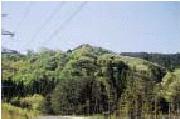
Distant view of Mt. Godai
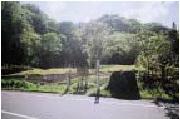
Signpost marking the entrance to Mt. Godai
Notes: Mt. Godai is west of the Tetsuzan Reservoir, which is upstream of the Yokokawa River Dam. You can walk to the summit in around 30 minutes.
47. Takakura no Monju Bosatsu Zo (Takakura Statue of the Bodhisattva Manjusri)
Location: Haramachi-ku, Takakura, Higashihata
Google Maps: Takakura Monjudo Hall
Owner: Believer in the Takakura area
Dimensions: Around 30cm tall
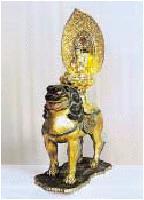
The Takakura statue of the bodhisattva Manjusri is the primary object of worship at the Takakura Monjudo Hall, and depicts Manjusri atop a stylized lion.
On the back of the statue is the inscription of its maker Kukai. It is said that around the time of the Genpun period (1736-1740), Dokeiji Temple’s 26th head priest Getsuko Zenshin donated 20 kanmon (monetary unit; 1 kanmon was worth 3.75kg rice), and made the Yurigusa boat-shaped halo of the statue of Manjusri as a monk with shaved head seated in a cross-legged position. The Takakura statue of Manjusri is one of the Three Soma Manjusri Statues alongside one in Kiyohashi (Namie Town) and one in Kamiura (Odaka Ward).
This Manjusri statue has been connected to extremely miraculous wonders since long ago. Once while a field fire was spreading all the way to the temple, a mountain guardian named Monzaemon broke through the lattice framework within the temple and went to remove the statue. However, he was unable to locate it and left empty-handed as the day reached its end. High priest Zeben Kakuhi searched the vicinity the following day and found the statue among the roots of a giant withered tree to the south of Monjudo Hall. Many viewed this as a miracle.
Notes: The statue is available for public viewing on the second Saturday and Sunday of January every year.
48. Izumi no Fudo Myo’o Sonzo (Izumi Statue of Acala the Immovable Lord [Fudoson])
Location: Haramachi-ku, Izumi, Terakemae
Google Maps: Izumi Kannondo Hall
Owner: Senryuji Temple
Dimensions: About 51.5cm tall
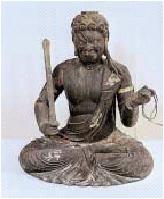
The Fudosondo Hall stands to the left of and facing the 11-faced Kannondo Hall in Terakemae (originally on the grounds of Tokoin Temple). According to the legend of Acala (a.k.a. Fudoson), Shofukuji Temple was built in facing Izumi Village in the Meireki period (1655-1657). In 1778, a holy man who ate nothing but fruits, nuts, and wild plants, known as a “mokujiki shonin,” came to the Soma domain and made the statue of Acala. It was later moved from Iwanosaku to Izumi in Odaka, and in 1828 it was moved from Shofukuji Temple to the grounds of Tokoin Temple. According to records used in Shofukuji Temple written in India ink, the Fudoson statue of Izumi Village came to the province in 1719. Construction of the temple began 60 years later in early April of 1778, and was completed in mid-May. Giten Seiko was the temple petitioner and resident of Shofukuji Temple. The “mokujiki shonin” also known as Mokujiki Gogyo (1718-1810) made a pilgrimage across the entirety of Japan, carving thousands of Buddhist statues, until his passing at the age of 93. However, the Fudoson statue was already in Shofukuji Temple before the legendary visit of the “mokujiki shonin” in 1778, so it can’t have been a posthumous work.
Notes: Temple festival days are the same as for the Izumi 11-faced Kannon statue: January 20, and the 3rd Sunday of July. On those days the statue will be unveiled for public viewing.
49. Shigetane Kou Odan (Burial Mound of Shigetane Ko)
Location: Haramachi-ku, Kamiota, Maeta
Google Maps: Ganokuji Temple
Owner: Ganokuji Temple
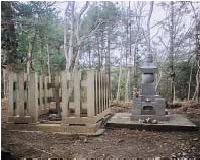
On the back of the summit of Otasan Ganokuji Temple is the grave of Shigetane, the 11th head of the Soma clan. The grave was constructed as a burial mound, a tomb shape which in this area is referred to as a “dan (壇),” or “mound.”
The shape of the mound crumbled around 500 years ago in the wind and rain. In April 1978, the bell tower of Ganokuji Temple was constructed, and a five-part gravestone called a “gorinto” was established as a memorial on the east side of the mound by laymen who loved and respected Shigetane, as he had originally laid the foundation for the temple.
Shigetane became the head of the clan in November 1436. However, he contracted an incurable disease, and after less than four years as leader, he yielded his position to his son Takatane.
He went to Ganokuji Temple on January 10, 1439, to take care of gravesites as part of the temple’s duties. Growing tired of worldly troubles, he entered priesthood and retired to Mt. Godai deep in the mountains of Baba Village, Namekata District (currently Baba, Haramachi District) to focus on recovering from his illness. However, his efforts proved ineffective, and he met the end of his ill-fated life there on Mt. Godai.
Notes: You can spot the location of his attempts to recover from illness on Mt. Godai.
50. Kitaniida no Odan (Kitaniida Burial Mound)
Location: Haramachi-ku, Kitaniida, Higashihata
Owner: Soma Kazutane and others
The Kitaniida burial mound is positioned on a hill on the north bank of Niida River. A tomb shaped into a mound is called a “dan (壇),” and this mound contains a graveyard of the Soma clan. Bordering the road that cuts through the area on the east side are the graves of six individuals: the 13th clan head Moritane, his wife, the 12th head Takatane, the 14th head Akitane, his wife, and the 17th head Toshitane’s daughter (older sister to the 18th head Yoshitane).
On graves from the Middle Ages to the early modern period, we can see the custom of piling up earth and planting evergreen trees like cedars, pine trees, and Japanese firs as marker trees. On the graves toward the back, grave tablets and “gorinto” were built rather than planting trees. The stump of a giant cedar tree remains on the top of the Kiitanida burial mound, a testament to how graves were constructed from the Middle Ages to the early modern period.
Please let the city hall cultural properties section know if you plan a tour to this mound.

Burial mound entrance and information sign

Grave of Soma Akitane
Notes: The Soma clan has various gravesite locations, with the 11th head Shigetane buried at Ganokuji Temple, and the 16th head Yoshitane onward buried at Dokeiji Temple in Odaka Ward. The graves of the 21st head Masatane and the 23rd head Takatane are at Daishoji Temple in Namie, buried during the period when burial methods were transitioning toward tombstones.
51. Tomita Kokei to Ninomiya Sontoku no Haka (Gravesite of Tomita Kokei and Ninomiya Sontoku)
Location: Haramachi-ku, Ishigami, Sakashita
Google Maps: East of Ishigami Lifelong Learning Center
Owner: Tomita Komei
The graves of Tomita Kokei and Ninomiya Sontoku are on the plot of the Tomita family gravesite. Ninomiya’s real grave is in Imaichi City, Tochigi Prefecture, but the one in Ishigami was built as a replica of that grave in 1955 to mark 100 years since Ninomiya’s passing.
The Tenmei Famine swept through all of Japan between 1781 and 1789, throwing farming communities in the Soma domain into ruin and dealing a devastating blow to the area’s financial state. In order to restore farming communities and solidify the domain’s finances, Sontoku’s disciple and Nakamura domain retainer Tomita Kokei introduced the Ninomiya method in 101 of the domain’s 226 villages for 27 years as Sontoku’s representative in the area, beginning in 1845 and yielding good results.
Kokei published “Hotoku Ki” and “Hotoku Ron” after Sontoku’s death and continued to pour his efforts into spreading Sontoku’s teachings. He passed away in 1890 at the age of 77 and was buried in the Tomita family gravesite.

Sontoku’s grave

Tomita family gravesite
Notes: Sontoku did not come to this area himself, but his wife and son moved here to avoid the horrors of the Boshin War and lived on the plot of land that now houses the Ishigami Lifelong Learning Center until 1890.
52. Ushigoe Jo Ato (Ushigoe Castle Site)
Location: Haramachi-ku, Gorai, Tate
Google Maps: Ushigoe Castle Site
Dimensions: Elevation – 73m; East-West – 300m; North-South – 280m
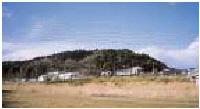
This castle site was occupied by Ushigoe Kazusanosuke Sadatsuna until it was overthrown by Soma Takatane in 1445. From then on it was under the control of the Soma clan, and a retainer of the Soma clan was established as the castle steward.
Later, Soma Yoshitane repaired Ushigoe Castle and moved there from Odaka Castle in 1597, controlling the domain from that location.
In May of 1602, while Nomaoi was taking place on the land near Ushigoe Castle, Soma Yoshitane was informed that since the had not participated in the Battle of Sekigahara on Tokugawa’s side, the domain was now confiscated. However, thanks to the efforts of Yoshitane’s son Mitsutane (later Toshitane), the clan was allowed to regain control of the three districts of Uda, Namekata, and Shineha in October.
The following year, the Soma clan abandoned Ushigoe Castle and moved back to Odaka Castle, citing the fact that Ushigoe was the castle at which the calamity of losing their territory took place.
Notes: This castle was a hilltop castle from the Middle Ages the early modern period, and the area has been well preserved. You can find the foundations of the inner citadel, the outer citadel, Higashidate (the castle’s outermost region), the surrounding castle walls and areas bounded by those walls known as “kuruwa,” and a dry moat among other past structures.
53. Kaihama Yo Suiro (Kaihama Irrigation Channel)
Starting Point: Nishiki-cho (formerly Sakurai Village)
Ending Point: Kitakaibama, Miyachi
Length: Around 4100 meters (inc. 930 meters of subterranean drain)
During the Tenmei and Tenpo Famines (latter half of 18th c. ~ middle of 19th c.), the number of households in the former village of Kaihama shrunk drastically from 117 households during its peak in 1709 to 38 in 1786. In order to restore the many farming communities that suffered from ruin and population decline due to the famines, the Soma domain introduced the Hotoku method as a village renewal project, achieving good results.
The large-scale irrigation projects were an enormous undertaking that were indispensable to the Hotoku method. A large portion of the reservoirs and irrigation channels within the domain were either repaired or newly constructed during this period. The Kaihama irrigation channel was constructed during this time to secure a source of water for the settlement of Kitakaibama, with its many shinken*.
This channel was completed in 1868 by the design and guidance of Ara Muneshige (nicknamed “Senpachi”), a follower of Ninomiya Sontoku, as well as the hard work of related parties.

Irrigation channel at the entrance of the Minamisoma Sports Center

Irrigation channel running alongside Sakurai Kofun Park
Notes:
*Shinken: policy measures in which new farmers from other domains came to the area, the second or third son of a farming family would gain independence and become a farmer, etc.
54. Uematsu Haiji Ato (Uematsu Abandoned Temple)
Location: Haramachi-ku
The Uematsu abandoned temple is a site from the Nara/Heian periods, known for the ancient roof tiles unearthed there. These roof tiles, a certain type of eave-end roof tile with the image of a clover, have a pattern that is rare throughout all Japan and is thought to be influenced by the ancient Korean kingdom of Goguryeo on the Korean peninsula. The same type of tile was excavated from an archaeological site (kiln site) in Nyudosaku, Kamikita-Takahira.
During an excavation there, tiles with the same design as those found at the Uematsu abandoned temple were found among other earthenware such as Sue ware, indicating that the tiles used at the temple were made at this kiln site.
The Uematsu abandoned temple is a valuable historic ruin, providing insight into the ancient history of the So-So area.
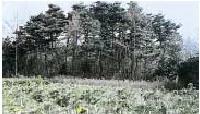

Notes: In the ancient literary source “Shoku Nihongi,” there is a record of a military corps being established in Shirakawa in 728C.E. It is thought that one was also established in the Namekata District around the same time.
55. Ninomiyake Jutaku Ato (Site of the Ninomiya Estate)
Location: Haramachi-ku, Ishigami, Sakashita
Google Maps: Ishigami Lifelong Learning Center
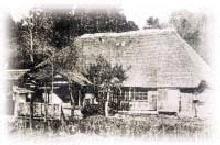
Former Ninomiya estate
In April 1868,Ninomiya Sontoku’s son Sonko moved from Edo to the Nakamura domain with his family to escape the Boshin War, upon invitation from the domain. The domain head at the time, Soma Tomotane, had a new home built for them in Ishigami Village (now the site of the Ishigami Lifelong Learning Center in Ishigami, Haramachi Ward). He also donated 300 bags of rice to Sonko every year. Both Sonko and his mother Utako passed away in 1871 from illness, so Sontoku’s disciple Tomita Kokei, originally from Ebisawa Village (Ebisawa, Odaka Ward) moved in just east of the Ninomiya estate to offer support to Sonko’s son Tachitaka and his family.
In 1877, Tachitaka, Tomita Kokei, and others formed the Reconstruction Company (復興社*), focusing efforts in Ishigami Village until Tachitaka moved to Hokkaido in 1897.
After the Ninomiya family moved to Hokkaido, their home in Ishigami Village was used as the village public office, but it became too small as time passed. Eventually, the entire estate was deconstructed and reconstructed in Nishimachi. The home deteriorated over time, eventually being completely demolished in 1970.
Notes:
*復興社: This organization was established to spread the teachings of the Hotoku method and collect funds for land reclamation projects.
56. Kanezawa Seitetsu Iseki Gun (Kanezawa Iron Manufacture Sites)
Location: Haramachi-ku, Kanezawa
Owner: Tohoku Electric Power Co., Inc., Haramachi Thermal Power Station premises
Google Maps: Iron Manufacture Preservation Site
The Kanezawa iron manufacture sites were unearthed in an excavation conducted by the prefectural board of education from 1989 to 1994 on the site where the thermal power station was planned to be constructed.
This site was in operation from the latter half of the 7th century to around the 10th century. It has been confirmed as the largest-scale ancient iron manufacturing site in Japan, with 123 iron-making furnaces, 149 charcoal furnaces, 133 pit dwellings, and 29 buildings with buried pillars.
It is thought that a new technique was introduced in the latter half of the 8th century which made it possible to produce high-quality iron in large amounts. At that time the central administration was attempting to control the Emishi peoples of northern Japan who had not surrendered. For that purpose, a large amount of weapons, farming tools, and other implements became necessary, and it is thought that the raw iron used for those tools was made here at this iron manufacture site. Tohoku Electric Power Co., Inc., constructed an underground cultural property preservation building in order to preserve these archaeological remains. The building is open to the public.
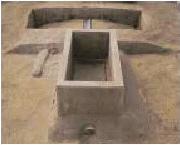
Restored box-shaped furnace
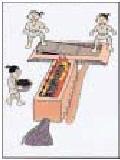
Image of iron manufacturing
Notes:
Open days: 2nd Sunday of April, May, September, and October.
Contact information: Tohoku Electric Power Co., Inc., Haramachi Thermal Power Station General Affairs Division
Tel: 0244-24-1614
57. Izumi no Sakaido (Izumi Sake Well)
Location: Haramachi-ku, Izumi, Miyamae
Owner: Ishibashi Tsutomu
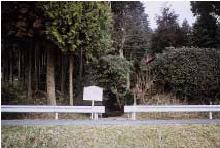
Izumi is the hometown of legends. There was once a wealthy person who called himself “Izumi chosha,” or “the wealthy person of Izumi.” It is said that he was originally from Kumano, Kishu (now Wakayama Prefecture, and was guided to live here by a divine messenger in the shape of a bird. Their estate (now in Terakemae) had cornerstones spread out across 11,900m2, where even now ancient roof tiles are still being found. Also, around 80 meters east of this estate is an eleven-faced Kannon, said to be the guardian deity of the rich person. Locals continue to pray to this statue today.
While there is no smell of alcohol from the well nowadays, it continues to produce clear spring water without fail.
Notes: It is said that high-quality sake once flowed from Izumi, Miyamae, which the wealthy person used to make his fortunes, and that he would send it flowing to the his daughter in Kobama roughly 8km to the south along a trough.
58. Namekata Hassha (The Eight Shrines of Namekata)
The eight shrines of Namekata that give an account of ancient beliefs at Shinto shrines. They were registered in the “Engishiki Shrine List” was compiled in the 10th century, thus also going by the name “Engishikinaisha” or simply “shikinaisha,”, meaning “shrine listed in the Engishiki.” There are 5 such shrines in Haramachi Ward.
As “shikinaisha,” the gods of these shrines were worshipped in connection to the subjugation of the Emishi people of northern Japan, and were established on land, on strategic points of sea traffic, and near military bases.
- Takakura Shrine (Maeta, Oshigama)
- Himatsuri Shrine (Tate, Omika)
- Sakamine Shrine (Michinoue, Shidazawa)
- Taka Shrine (Kotarouchi, Taka)
- Oshio Shrine (Suwa, Kitaniida)
Notes: Namekata district: The name of the Namekata district was first seen in 718C.E. The district once contained six townships.
- この記事に関するお問い合わせ先
- このページに関するアンケート
-
より良いウェブサイトにするために、このページのご感想をお聞かせください。















更新日:2021年08月19日